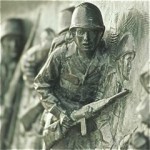In this third part of a series about body language that impacts salespeople, we focus on interpreting the thumb and finger rub and take a look at what clenched hands mean. Read more
 More non-verbal cues to help you succeed in business
More non-verbal cues to help you succeed in business
In this third part of a series about body language that impacts salespeople, we focus on interpreting the thumb and finger rub and take a look at what clenched hands mean. Read more
 Body language in sales: hands steepled – a positive or negative gesture
Body language in sales: hands steepled – a positive or negative gestureFingertips in the steeple position is one gesture that can be understood and interpreted in isolation from other gestures. People who are confident, superior types or who use minimal, restricted body gestures often use this signal, and, by doing so, they convey their self-assured attitude. Read more
 Non-verbal cues: rubbing palms together signals positive expectation
Non-verbal cues: rubbing palms together signals positive expectationWhat does your body communicate when your prospect says: “Your price is too high?” Think of your last sales call and try to remember specifics – your body angle, facial expressions, the position of your arms, hands and legs. Most salespeople show negative changes in their body posture when hearing objections. Read more
 Don’t be too busy to say thank you
Don’t be too busy to say thank youDoes it ever seem to you that “all you ever needed to know you learned in kindergarten?” Saying “thank you” is one of those important life lessons. In the overstressed, busy world where many of us live and work, sometimes, saying thank you may not seem a high priority. Read more
 How to make a presentation interactive
How to make a presentation interactiveAs a presenter, you always want to know your audience. When presenting to hundreds of audience members at a large event, you could troll the lobby and get a feel for how some will react to your content. Some venues may even offer interactive polling where you could open some questions and get immediate feedback from audience members holding voting devices. Read more
 Use the principles of war in your next presentation
Use the principles of war in your next presentationIn business, we may tend to think of our competitors as “the enemy.” But, we rarely engage our competitors directly. Rather, we fight a two-front battle against forces that have the power to utterly destroy our ability and will to fight. Those forces are one, our customer, and two, ourselves. Read more
 How to run effective meetings: 5 tools to build consensus
How to run effective meetings: 5 tools to build consensusConsensus building tools help you get through meeting impasses or inaction.
Don’t let your meeting get bogged down due to an impasse or sudden lack of attendee action. Learn how to retain and combine members’ best contributions and maximize results. Read more
 3 ways to help you use storytelling to rally the troops
3 ways to help you use storytelling to rally the troopsAllen Schoer has a lot of good ideas when it comes to storytelling! Read this post for some of his thoughts and my comments. In another article, he makes the point that anyone in a leadership role – particularly the CEO – must have strong storytelling skills to rally the troops. Read more
 5 steps to convince people to change their behavior
5 steps to convince people to change their behaviorConvincing your listeners to stop something is always harder than getting them to buy into a new idea. Bringing a current plan to a halt requires people to admit the idea was bad. Smart people like to be right and will often defend an idea to death. Peer pressure also drives communal thinking, making it even harder to convince a large group that the idea is bad. Read more
 5 lessons to write a memorable speech or presentation
5 lessons to write a memorable speech or presentationAs John F. Kennedy closed his inauguration address on that blustery January day in 1961, he made the famous challenge, “Ask not what America will do for you, but what together we can do for the freedom of man.” Evaluating this address uncovers how to prepare words that will resonate for decades. Read more